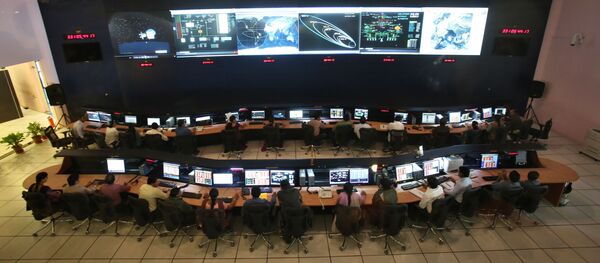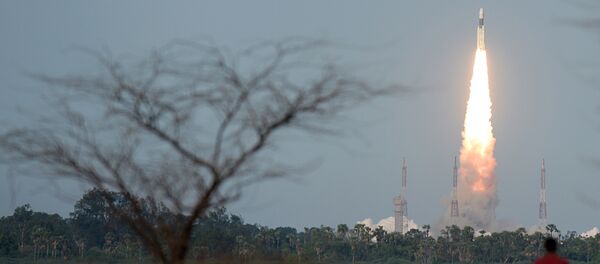The Indian Space Research Organisation (ISRO) has started to offer details about its most ambitious space mission to date, Chandrayaan 2, in bits and pieces, indicating that the agency is known for cost-effective launches among satellite-makers and may not delay the second lunar mission any further.
ISRO has announced that all the modules are being prepared for the launch of Chandrayaan-2 during the window of 9 July to July 16, 2019, with an expected Moon landing on 6 September 2019.
The Chandrayaan-2 mission is a sequel to the successful Chandrayaan-1 mission, that assisted in confirming the presence of water on the moon in 2009.
READ MORE: India Prepares For Second Lunar Mission with Chandrayaan-2
So far, only Russia, the US, and China have undertaken the 384,600 km (239,000 mile) journey and landed spacecraft on the moon. Earlier this year, Israel made an unsuccessful attempt to join the elite club, but its mission failed.
— ISRO (@isro) May 15, 2019
First-Ever Landing at South Pole
The Rover is housed inside the Lander. ISRO hopes to land modules near the south pole of the moon, below a latitude of 70 degrees, a location no other country has explored before. In the most complex mission ever undertaken by ISRO, it will deploy a rover on the lunar surface. After reaching a 100 km (62 mile) lunar orbit, the lander will softly land on the lunar surface and deploy a rover, while the orbiter will continue to orbit around the moon.
"After launch into Earth-bound orbit by GSLV MK-III, the integrated module will reach Moon orbit using the Orbiter propulsion module. Subsequently, Lander will separate from the Orbiter and soft land at the predetermined site, close to the lunar South Pole," ISRO said.
Chandrayaan —2 will carry 13 Indian Payloads (8 on orbiter, 3 on lander and two on Rover) and one passive experiment from the US space agency NASA. The payloads will collect scientific information on lunar topography, mineralogy, the abundance of elements, the lunar exosphere and signatures of hydroxyl and water-ice.
— ISRO (@isro) May 15, 2019
More Complex than NASA's Apollo Mission
The rover will collect information for at least 14 Earth-days and cover an area with a 400-metre radius. The instruments on the rover will conduct the in-situ (on site) analysis of elements such as sodium, magnesium, aluminium, silicon, etc. and the distribution of water on the moon's surface.
ISRO emphasised that the mission will expand India's footprint in space. "The Moon is a perfect test bed for providing technologies required for future space exploration as well as in-situ resource utilisation," ISRO added.
Notably, the success rate for lunar landing missions is less than 50%, as 27 of the 47 lunar landings attempted have failed. ISRO has already tested a model of the small (25 kg) Chandrayaan-2 rover for lunar-gravity operations for months.
Last-Moment Changes
Earlier, ISRO had planned a 22,000 km orbit for a 3.2 tonne spacecraft. At a later stage, however, because of the increase in mass, the orbit was increased to 37,000 km. ISRO also had to redesign the lander, as it was found only last year that there was some problem in landing.
— ISRO (@isro) May 1, 2019
Total Cost of the Mission
"This cost is almost half of $232 million, which would have been otherwise incurred if the same mission had to be launched from a foreign launching site," K. Sivan, ISRO chairman, had said last year during his discussion with India's Minister of State for Space Jitendra Singh in New Delhi.
Chandrayaan-2 was originally envisaged and approved by the Indian Government in September 2008 at a cost of approximately $92 million, excluding cost of GSLV rocket and Lander.
Foreign Partners
In accordance with suggestions made by Indian scientists, ISRO decided to go it alone in the mission. Some reports stated that NASA and the European Space Agency were interested in participating, but ISRO proceeded with the mission on its own.
READ MORE: India, Japan Plan to Jointly Explore the Moon
Indian-Made Content
ISRO has distributed lots of work to private and state-owned units related to the mission. However, it hasn't revealed the work share as of now. State-owned Hindustan Aeronautics Limited supplied the Orbiter Craft Module structure, which is a 3-tonne category bus structure made out of a central composite cylinder, shear webs and deck panels.
First Mission
ISRO launched its first moon mission, Chandrayaan-I, in October 2008. The mission had five payloads from India, three from Europe, two from the US, and one from Bulgaria. Although the mission was expected to last two years, it only lasted for roughly 10 months after the orbiter stopped communicating with the station in August 2009.





